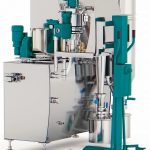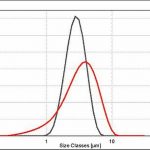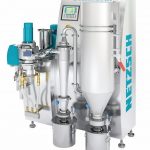When designing the Lab Compact Plus, Netzsch considered typical laboratory conditions drawing on its own experience from decades of running a laboratory. The outcome: a plant with a stable, reproducible throughput and high product yield as well as production parameters that can be flexibly selected by the user. Thanks to the modular principle, five different systems can be installed in the machine’s swivel arm. They are easy to exchange using individual connector sets for electricity and compressed air. Amongst other things, the machine modules determine the final particle size and can be optimally adapted to the requirements of each particular product. Customers can choose between a fluidised bed jet mill, a high-density bed jet mill, a classifier mill, a fine classifier and last but not least a high-efficiency fine classifier, which Netzsch offers from a single source. Each of these components has been tested and optimised in conjunction with the Lab Compact Plus.
For any specification
The type of size reduction – and hence the selection of a suitable machine – depends mainly on the specified particle size, shape and size distribution. The downstream processing steps are a further factor, as is the amount of product to be ground. The deformation behaviour of the size reduction product, which can vary from brittle-elastic through inelastic or elastic-ductile to elastic-viscous, is another important criterion which influences the machine technology.
Jet grinding on a laboratory scale
Defined fine grinding of even the hardest materials (up to 10 Mohs) with an exact upper particle size limit is possible using a CGS 10 fluidised bed jet mill, which combines an air jet mill with an integrated, dynamic air classifier. In the fluidised bed, which is fluidised by gas jets, particles are accelerated in an open jet and then impacted against other, slower particles on the way to or in the actual centre and hence ground. Grinding is completely autogenous and is therefore free of contamination. The particles are transported to the classifier wheel by the gases ascending in the centre. The wheel rejects any particles which are too coarse, only allowing those whose size corresponds to the set parameters to pass through. The desired final fineness can be set by steplessly adjusting the speed of the classifier wheel and varying the amount of grinding gas. In the d97 fineness range from 2.5 to 120 µm this proven grinding technology is suited for even tiny amounts of product on a laboratory scale.
The Conjet 10 is the only laboratory-scale spiral jet mill featuring an integrated classifier which unites the advantages of a conventional spiral jet mill and a dynamic classifier wheel. This combination enables the Conjet 10 to achieve the highest finenesses and the steepest possible particle size distribution regardless of the product load, and therefore also higher throughputs. The adjustment of the grinding fineness via the product load – normally unavoidable with conventional spiral jet mills – is thus eliminated because the speed of the classifier wheel is settable. Thanks to the residue-free grinding and low build-up of deposits inside the machine, the Conjet is ideal even for high-value products.
Impact grinding on a laboratory scale
A fine impact mill is another option for producing finer final particles with a defined upper particle size limit if a dynamic air classifier is integrated in the grinding chamber housing. This can be achieved using a CSM 50 classifier mill. Grinding takes place between a peripheral grinding track and a grinding disc equipped with beaters. The impacted product particles are transported into the upper part of the machine by the classifier air which is supplied and then presented to the variable-speed classifier wheel. Depending on the set conditions (classifier speed, air volume), only appropriately fine particles pass through the classifier wheel. Finenesses ranging from 30 to 800 µm (d97) can be realised with the classifier mill.
Ultra-fine classification
Due to their particle size distribution after a manufacturing or grinding process, some products are still not suitable for further use at this stage. Subsequent treatment is required for an exact particle size fraction, in order to optimise the desired product characteristics or to actually obtain them in the first place. Classification into particle size ranges 100 µm is usually achieved with screening machines. If particles 100 µm in size must be separated, then the use of air classifiers is often indispensable for controlled separation. Air classifiers solve typical problems, for example by eliminating undesirable coarse particles or significantly reducing the fines fraction (dedusting).
The CFS 5 ultra-fine classifier is an air classifier for classifying fine powders down to a medium fineness range from 20 to 150 µm (d97). The product is separated into two fractions (fine and coarse) using a carrier gas and a rotating classifier wheel by generating fine and coarse product mass flows from a feed mass flow. The desired separation limits are adjusted by steplessly varying the classifier speed. Easy access is guaranteed for cleaning purposes.
The diversity of the potential applications demands ever higher degrees of separation and finer separation cuts. This has led to the development of even more efficient ultra-fine classifiers enabling optimum pre-dispersion. The CFS 5 HD-S high-efficiency fine classifier significantly increases the possible fineness (d97 = 2.5 to 100 µm), degree of separation and yield owing to the peripheral guide vane ring around the classifier wheel and the improved wheel geometry.
Typical applications
When manufacturing neodym-iron-boron magnets (Nd-Fe-B), a narrow particle size distribution and as few very fine (2 µm) and coarse (8 µm) particles as possible are decisive with regard to quality and properties. Sensitive Nd-Fe-B compounds or other rare earth alloys can be reduced reliably and reproducibly to fine powder with a narrow particle size distribution and a defined upper particle size limit with the help of an optimised version of the Lab Compact Plus. The compact, airtight skid is used for this purpose under inert conditions (N2 or argon atmosphere) and the oxygen content monitored by a lambda sensor. PU-lined components prevent product build-up while special product feed and collection tanks with rinsing connections for argon and N2 guarantee safe handling of pyrophoric compounds.
The M-Jet (a more advanced version of the Conjet), a high-density bed jet mill for rare earth applications which allows difficult-to-grind components to be automatically rejected without contaminating product-contacted sections of the piping, was developed by Netzsch to facilitate size reduction.
The dynamic air classifier integrated in the M-Jet ensures a defined upper particle size limit of the ground product. Ultra-fine fractions can be separated as required in a downstream step by classifying the grinding product with a Netzsch high-efficiency fine classifier to give a powder with a defined, narrower particle size distribution. The M-Class, which has a special guide vane basket (similar to the CFS/HD-S) and is optimised specifically for rare earth alloys, is employed for this classifying step.
Online search: cpp0318netzsch












